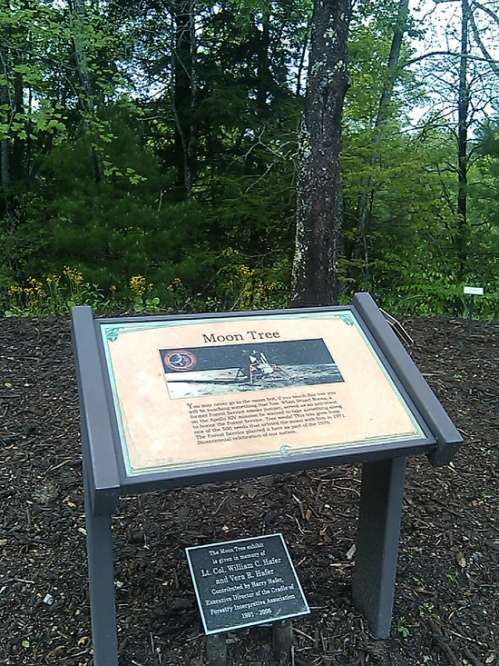Dash for the ‘Stache Recap
A flash of light woke me around 3 am. I thought someone had flicked a light in the bedroom and left the water running in the bathroom. But then I remembered. I was in a tent. The running water was from the nearby stream, the flash was lightning. In that foggy no-man’s land where my brain resides when awakened from a dead sleep, several related thoughts raced through it at once: Damn, the forecasters were right after all—rain. But for how long? The entire race? Was it cold, too? Didn’t matter, I reminded myself. I was going to run regardless. I’d heard from the office Friday afternoon that the Dash for the ‘Stache had already raised $1,600 and I couldn’t disappoint those folks (the total is now over $2,000—and you can still give). I just hoped that it wouldn’t rain Saturday night, too. My last thought before drifting back to sleep was that Smokey Bear would be pleased. Our campfire was good and drowned.
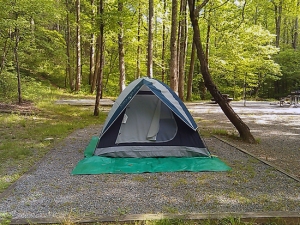
Friday evening’s weather was perfect for camping. Friday night’s weather was perfect for ducks.
About two hours later, I woke up to find my lower back cold and wet. Now all I could think of was the sign on the footbridge from the parking area to the campsite that warned of flash floods. My brain immediately went there—I’m about to become the subject of a freak news story, the camper swept away in a flash flood. I reached behind me and found a puddle, not a stream. Okay, maybe I won’t float away after all. But the sleeping bag was acting like a sponge and soaking up the water. I tried spinning and contorting like an acrobat to avoid the wet spot, but there was no way to escape it. It was done and so was I. I listened to the slow thwip thwip thwip of the water coming from the roof peak and on to the sleep pad for a few more minutes. The rain outside sounded like it was coming down harder than before, which meant it was going to do the same inside. I sighed as I began the process of extricating myself from the synthetic cocoon, all the while trying to avoid the puddle and wet bag. I got dressed, found my headlamp so I could see to tie the boot laces, grabbed my jacket and hat, and headed for the bathroom and then the car for a little more sleep, if I was lucky.
As I approached the car, it was light enough that I could barely make out Jason sleeping in his car. New to trail running but not camping, he had taken the forecast seriously and decided not to risk using a worn-out rain fly and opted to spend the night in his car. He was looking like a genius. Then I heard POP POP POP POP. Gunshots? At 5:30 in the morning? Who’d be hunting in this weather? Get a life, I thought. And get in the car. Wearing a green raincoat in this low light, I might be mistaken for a deer or Sasquatch’s shorter brother. I climbed in my car and shed my raincoat so I wouldn’t be sitting in another puddle. And then I heard what sounded like a large creaking door followed by WHOMP. That got my attention. I hadn’t heard gunshots—it was a tree snapping and then falling over. Oh, crap, I thought. I hope that tree didn’t just block the road. We’d never make the race.
My next thought was about the other campers. (Runners can be a bit self-involved. My first thought really was, If the road is blocked, how will I get to the race? Can I run to it from here?) We’d all set up under some big old trees. Do I go warn them? I took some comfort in knowing that the sound came from behind me. The campsite was in front of me, and my fog-filled mind said the trees looked solid and posed no danger. It was a Faustian bargain. I was willing to trade my friends’ lives for 10 minutes of sleep. Besides, the trees didn’t look as old as I was feeling right then. I was sore and tired and had had a fitful night of sleep. I’d gone to bed about an hour after everyone else so I could enjoy the campfire by myself. Jason and Steve and my friend Halle and I had talked around the campfire until around 10. Steve’s a forester who, after graduating from N.C. State in 1983, has spent the last 27 years working for the Department of Corrections managing some of their lands. He and I figured out we knew some of the same forestry folks while watching Jason work miracles with sausages and sticks as he prepared his dinner over the fire. Before turning in, Jason pumped the three of us for tips and info that might help him get through the race. He’d never done a race longer than 13.1 miles or a trail race. Tomorrow was uncharted territory for him. While we three grizzled veterans of the recent Umstead Marathon traded stories and shared tips, I’d tilt my head back and look at the moon slip in and out of the clouds, hoping that I could sear that image into my memory. No camera would capture that beauty. It’s why I had opted to camp out before the race. You just don’t have these experiences in an anonymous hotel room.
But now I was in my car trying to grab what little sleep I could. I kept fidgeting while trying to get warm. The alarm was 15 minutes from going off when Steve appeared at his truck. He’d already begun breaking camp and getting ready. We’d calculated the drive to the Cradle of Forestry site, where the race would begin and end, to be 30 minutes. We needed time to break camp, which would now be more challenging because of the rain, change into our running gear, maybe eat, and hit the road. We loaded our vehicles and formed a caravan, climbed up the mountain in the fog and rain, found our parking spaces, and sat there, each of us alone in our cars, going through our mental checklists. Mine consisted of: Eat more food or you will bonk! Check that you’ve got energy packets in your fuel belt or you will bonk! Do I bother with pull-on sleeves, wear a long-sleeve t-shirt, or just go with short sleeves? Which socks should I wear? For a runner, this is a critical decision. The wrong choice could lead to blisters and miles of misery. It was especially crucial with another race the next day. In the end, I chose correctly. We had several stream crossings and slogged through a lot of mud. The formfitting socks didn’t move on my feet, and so they didn’t rub the skin anywhere. At least my feet would be ready for the Biltmore race the next morning.
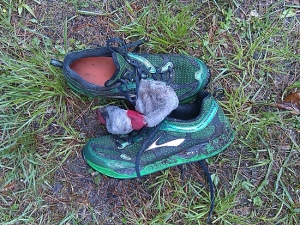
When the day started, the socks were red and white. But when it ended, I didn’t have any blisters!
Close to 400 runners and their stalwart supporters piled into the Cradle of Forestry Forest Discovery Center to avoid standing around in the rain. It was 60 degrees, and the rain didn’t appear inclined to give way. Perfect weather for a trail run—60 is an ideal temperature and clouds meant no overheating from the sun. The rain would keep me cool but not chilled. But no one wanted to hear the pre-race announcements, even though that meant getting to stay inside a bit longer. We just wanted to run. The morning was going to be long enough as it was. Some runners headed out mid-announcement, and word was relayed to the race organizers that the race was going to start with or without their blessing. We gathered outside, anxious to get moving. We didn’t want to stand in the rain; we wanted to run in it. The grumbling grew louder, ended only by the starting gun and the cheer it elicited. The Dash for the ‘Stache—all 45 kilometers of it—was finally underway.
We started by going around the visitor center on the paved Forest Festival Trail, including past the restored railroad locomotive, which allowed me to share what little knowledge I have about them with Halle. (The 5K race goes through the forest school’s campus.) After a mile of looping around and jockeying for position, we headed out into the Pink Beds. I’ve never been lucky enough to visit the Pink Beds when they are in full bloom, and today was no different. Even if they had been, the trail would take all my attention and concentration. Every effort would be needed to avoid turning an ankle.
The course was a mix of pavement, single track (where the trail is wide enough for one person), double track (two people wide), and Forest Service road. Along the way, we stepped in water-filled holes that were knee-deep and stretches of trail that were shoe-swallowing mud. Being in the second half of the pack meant that those stretches were pretty well trashed by the time we came through, making footing treacherous. The stream crossings were more like fording small rivers. It’d been raining for the last week or longer and the water was fast. Good thing they’d strung rope across the streams to cling to while crossing. The water was bracing, but it cleaned the mud off my shoes and made them lighter once the water had squished out.
As we trekked along, I occasionally lifted my gaze long enough to note the scenery changing from heavily wooded areas to parklike settings with open views across fields of ferns. We picked our way over three miles of trail before finding the first aid station and getting on the Forest Service road. On our way to the third aid station, probably at around mile 7, the leaders passed us going the other way. I figured that the climb up to Slate Rock must not be too tough if they were making that kind of time. Cue the ominous music.
At the third aid station, we turned off the road and started the long climb to Slate Rock. The race’s elevation chart is misleading, in part because it’s so small on the web. It shows the rise in elevation, but not what the terrain is really like or how quickly you are climbing about 600 feet. Several times we slowed to a walk. As we ascended, we climbed up into the clouds. We hadn’t seen anyone since the aid station. It was quiet. I wondered if we’d somehow gone off the trail. I joked that we must have died and were actually climbing to runner’s heaven. Then we heard other runners ahead of us. We weren’t lost after all. We took the turn out to Slate Rock, where the race organizers had stationed someone to photograph runners on the ledge.

Image courtesy of Cradle to Grave 30K. To see this and other photos from the race, click on the image.
After having our pictures taken, we refueled while soaking in the beautiful fog-enshrouded valley below us, we were off again. More climbing took us up and over the ridgetop. We walked a bit more because of the rocky trail before resuming the run. Halle loves the downhill portions of a trail run, and it was easy to see why. At just over five feet tall, from a distance she appears to be not much bigger than the bunny she resembles as she bounds downward, hopping sprightly from rock to rock and around trees and less confident runners. I lumbered down behind her, moving more like the Sasquatch of earlier that morning.
The course eventually brought us back down to the third aid station and onto the road. Four miles later, we found ourselves back at the first aid station and returning to the trail. Instead of doubling back all the way, we went about half a mile before taking a different path that sent us out over wooden walkways that traverse bogs and swampy areas. It was nice not to be running through the muck anymore. Fatigue had settled into my legs a few miles back and I was ready to be done. The masochist who had laid out the course had one more surprise for us though. We had about two miles of trail to run before arriving back at the visitor center. When your legs are already dead, lifting them just a little more to safely clear tree roots is more challenging than it ought to be. Steve was right when he said that the American beech, with its shallow and exposed roots, is the enemy of trail runners. This is often the most dangerous part of the race. When you’re already too tired to keep running, it’s so easy to trip and fall while scuffling to the finish line. But neither of us did. I finished upright, the goal I have for every race. (You can view all the photos from the Cradle to the Grave 30K here: http://www.flickr.com/photos/96321150@N08/sets/)
We walked back to the cars to stretch, dry off, check for blisters, and change into dry, warm clothes. A few photos to document the race later,
we headed to the amphitheater for food and drink and live music. When it comes to food after a race, I have the “ground glass” rule that says, if hungry enough, I’ll eat ground glass. The offering wasn’t ground glass: it was perhaps the greatest pork barbecue in the history of pork or barbecue. I didn’t even mind the coleslaw on it. At this point, I was willing to eat anything, even vegetables. After lunch and a walk around the visitor center to photograph the moon tree, it was time to hit the road for the next race. With the sleeping pad and bag sopping wet and the tent worthless, I opted for a hotel room in Asheville near the start of the next day’s race.
I went to dinner in town at an Italian restaurant. A gentleman in his 70s at the next table overheard me tell the server what I had done earlier that day to earn the big lasagna dinner I’d just ordered and spun around to ask me about the race. He had just been looking at photos of it on Facebook! We got to talking and I learned that he was a runner too. He had wanted to do the accompanying 5K race at the Cradle but since he races every other weekend, this was his weekend off and, well,… Next year, he said. I’ll do it next year. We talked about our respective running groups and how important they are to each of us. As we chatted, I noticed his wife patiently if vacantly staring out the window at passersby. She was clearly a “running widow” and had heard this conversation far too many times.
After too short a night of sleep, the alarm was going off at 5 am. It had rained off and on during the night, and I was grateful to have a solid roof over my head. The Biltmore race required all participants to be on the estate grounds by 6:30 for the 7:15 start. This time I was sure to get coffee and some breakfast. It started to rain as I got in the car. It stopped briefly before resuming just before the race started. “Here we go again,” I thought. While trying to stay warm, I noticed a runner from the day before and introduced myself. As we were discussing what muscles hurt and which ones didn’t, another guy came over and said, “Hey, I recognize you two nuts! You ran yesterday!” He had been at the Cradle to cheer on his daughter, and the two of them were running the Biltmore 15K. We introduced ourselves, made small talk, and then parted company just before the gun went off.
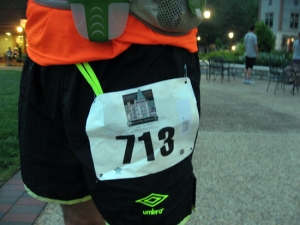
Number 713 in the ledger, number 1 in your heart?
The race starts at Antler Hill Village and passes Deerpark, out toward the ticket center and up to the Biltmore House. As we made our way past the barns on the way to Deerpark, you could hear the goats inside chattering away. It was perfectly peaceful and idyllic. What I’d forgotten about the estate is that the house sits up on a hill, and that Frederick Law Olmsted had designed 3-Mile Approach Road to climb that hill in a meandering fashion so that you can’t see the house before you emerged from the trees just beyond it. So from Deerpark on, this meant a 4-mile climb, in the rain. Then you circle in front of the house and someone (supposedly) takes your picture with the house in the background (I have yet to locate mine on the photo website).

It was a great weekend to be a duck. Or a goose.
I thought climbing the hill was tough, but going downhill when you have exhausted thighs is tougher. But down we went, through the walled garden, passed by the bass pond and waterfall, and back onto the main road, running through the fields and back to the winery. I heard later that they had incorrectly measured the course, that it was really 9.6 miles instead of 9.3. I believe it. Or at least my legs did. I crossed the finish line at a much slower pace than I’d hoped for, but it didn’t matter. Nearly 28 miles later, the Dash for the ‘Stache was done.
After changing and getting something to eat and drink, I hung around the village long enough for the exhibit on the Vanderbilts to open and quickly made my way through it. I was pleased to find a quote from Carl Schenck’s memoir Cradle of Forestry on the wall but disappointed that it was about the arrival of George Vanderbilt’s new bride. With all the clothes and china and silverware on display, it was like walking through a tribute to Downton Abbey, which only made sense since this was the setting for the “Downton Abbey of Forest History.” I was most interested in seeing what if anything they had about the forestry work at the Biltmore. They did have a bit of info at the end—almost an afterthought, and certainly not enough for my taste. It talked about Olmsted and Pinchot’s work on the estate, Schenck’s Biltmore School, and Vanderbilt’s legacy—how what had once been Vanderbilt land became the first national forest east of the Mississippi River. It felt good knowing that I had just been there, and it was because of George Vanderbilt’s vision that I could go there. Curiosity satisfied, I made my way back to the hotel, checked out, and pointed my car east in search of food and forest history—one to feed my stomach, the other my soul.
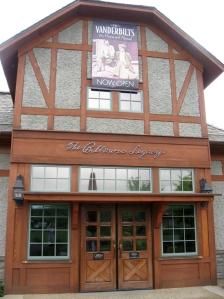
Overall, the “Biltmore Legacy” exhibit is quite informative and well done. If you want more information about the Biltmore’s forest legacy, visit the Cradle of Forestry in America site instead.
After a late breakfast at my favorite healthfood restaurant, I turned off the interstate at Old Fort and headed up Curtis Creek Road in search of the Weeks Act history marker. The road narrowed as pavement turned to dirt and soon enough I found it. The sign had been installed around the time of the 50th anniversary of the act. I took some photos of me where Chief Richard McArdle had stood beside it. (It was later that I realized they had replaced the sign since he was there.) I spent a half-hour or so there, enjoying the solitude by Curtis Creek before I eased behind the wheel to start the climb up to the Blue Ridge Parkway in search of the marker installed for the act’s centennial.

A jubilant Chief McArdle at the Weeks Act historical marker in 1961.

A jubilant Jamie Lewis at the Weeks Act historical marker.
I stopped just passed Newberry Creek Road to photograph a Civilian Conservation Corps marker commemorating the CCC camp that had been there. The road from there on is classic Forest Service road, an engineering marvel of hairpin turns above sheer dropoffs with lots of ruts and potholes to up the difficulty. (Allow plenty of time to get to the top–it’s 7 miles from Newberry Creek and about 2,200 feet of elevation change.) While crawling up the mountain, I went in and out of fog, much like the day before. When I hit the Blue Ridge Parkway and turned left to go to the marker, I hit fog as thick as peanut butter. The historical marker was visible, but the view from Laurel Knob Overlook made a mockery of the text on the sign: I couldn’t see the tract before me. I could barely see the sign. I took pictures of the ghostly trees and stuck around for a few minutes before deciding that the clouds weren’t going to lift for several more hours and began the long drive home.

The view of Curtis Creek from Laurel Knob Overlook.
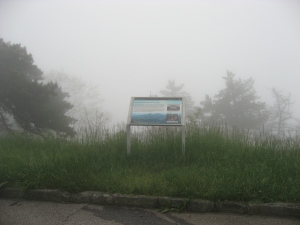
The Weeks Act Centennial marker proclaims: “The 8000-acre Curtis Creek tract before you was the first parcel of land acquired under the Weeks Act.” I took the marker at its word.

I left before the tree monster could turn and attack.

